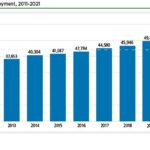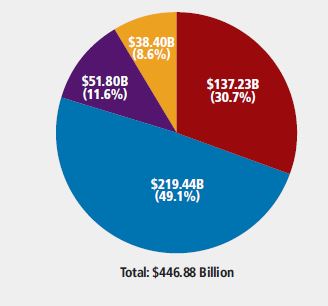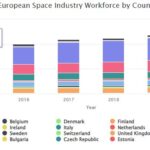Poland
European Space Industry Employment, 2011-2021


European space employment was 53,051 in 2021, an increase of 5.4% from the total of 50,317 from 2020. This estimate is based on analysis by Eurospace, the trade association of the European Space Industry. The analysis focuses on the space manufacturing industry; space services companies such as Ariane- space, SES, Eutelsat, and Inmarsat which also employ thousands of individuals, are not included.
Europe Continues to Lead in Global Workforce Job Growth


The space industry relies on skilled individuals from a wide variety of fields to enable the cutting-edge developments taking place in this sector. While many countries do not regularly produce metrics on the size of their workforce, these data are available for several major space actors, including the United States, Europe, Japan, and India.
Rivals Launch Military Satellites Amid U.S.-led Space Defense Drills


A flurry of military and intelligence satellite launches by rival powers this month came as the United States and two dozen partner nations wrapped up the largest global space defense wargame in history.
Russia launched what some leaders have described as a spy satellite for Iran and its own on-orbit snooping satellite Cosmos-2558, which is circling Earth in an orbit conspicuously close to a recently launched U.S. National Reconnaissance Office satellite, a Netherlands researcher confirmed.
2021 TSR – Space Symposium Special Edition: Global Space Economy Climbs Despite Pandemic, Disrupted Government Spending


The global space economy reached a new high of nearly $447 billion in 2020, an increase of 4.4% from a revised 2019 figure of $428 billion. The 2020 figure is 50% greater than a decade ago, and 176% greater than . . .
2019 TSRQ3 – Education STEM Proficiency


The science, technology, engineering, and mathematics (STEM) workforce is at the core of the space industry—from the mathematicians and astronomers who analyze space to the engineers who design and build the launch vehicles that get us there. This workforce is enabled . . .
2019 TSRQ2 – Economy: Non-U.S. Government Space Investment


Growth in the government investment sector of the space economy outpaced commercial sectors as the U.S. and non-U.S. government shares of the global space economy between 2017 and 2018. . .
2019 TSRQ2 – Workforce: Domestic and International Space Industry Employment


The global space industry employs hundreds of thousands of highly skilled individuals to design, produce, and operate cutting-edge technology. This dynamic workforce contributes to local economies, with clusters of innovative companies and service . . .
2017 – Government Space Budgets
Global government spending increased in 2017, totaling $76.2 billion, up from $72.7 billion in 2016. Government spending accounted for 19.9% of the global space economy . . .
European Space Industry Workforce by Country 2000 – 2020


Stacked bar chart showing a twenty-year look at the European space industry workforce by country 2000 – 2020
2013 – Military Communications
Dedicated and secure communications links are vital to defense agencies around the world. Increasing demand for capacity—particularly secure connectivity using non-commercial frequency bands—has driven the deployment of dedicated military communications satellites. The U.S. military buys a significant portion of its capacity from commercial operators such as Intelsat and SES. However, the United States also relies on military-specific systems such as the Wideband Global SATCOM (WGS) program, supplying dedicated communications to U.S. and allied military forces around the globe.